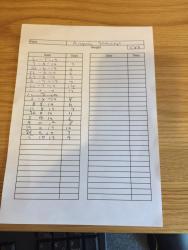Okay happy to share my experience having a collection of succulents, and caudiciforms over the last 10yrs or so.
So I cant lie for quite a few years my watering was automated on drip lines, but that doesnt really matter much anymore. If anyone does want to know the specific intervals for drip lines I figured out please ask and I will share them. It took a while to get it dialed in.
(1)On average, specific specimens may get a little higher or lower, I water about 3 times for week for growing season, completely saturating it each time I do. depending on which plant it is it may truly only take a day or two to already dry out. And to go along with it since I have very little organic material in soil mix I ball park about 50% ratio fertilize 2 times and then low dose at 25% ratio the third time I water, then every once in a while (about every 2 weeks) I flush water it with no fertilizer in it.
I also usually water initially just partially and then come back around hit them all again until water floods out the bottom. This does not take much water to do this, becuase the actual soil water potential is lower and weaker due to larger aggregate size and large pore spaces. My soil mix also has a pretty low field capacity, on purpose. I really dont like growing succulents in soils with greater field capacities. With my mix it allows me to put water onto feeder roots, without excess moisture, more often, leading to better root and shoot growth, and less disease problems.
(1) during dormancy I water off of the first #2. but when I do need to water I do not water completely I have found it safer to water in much smaller doses during dormancy. this helps with not over watering.
(2) For me my biggest indicators I use to know when to water with my caudiciforms is turgor pressure. This is a pretty fool proof way for anything that trunk swells or deceases. I simply press firmly against the caudex and if there is any give after a few days from last watering then I know I can water again. This is my go to reference point for most caudiciforms. I dont recommend trying this method with cacti

(2)In combination with that I water off of the weight of the pot when picked up. Takes a little bit of muscle memory, but im pretty good about knowing how each pot feels between completely watered down to dry.
(3) For outdoors based off of my 2 number 2's most everything gets treated the same outside. But the Larger speciemns get a little more often watering. For inside I water about 1 time a week, after picking up the pot and checking for weight.
(4) For me because of the type of soil I grow in (75% aggregate), please refer to my post in the next sticky, I water a lot. And I like it this way. This may not work for everyone but it allows me to have more control over moisture levels with out holding too much for too long and this also allows me to fertilize with pretty consistent frequency, without burning or getting into toxicity levels.
- I have a mix of pots from plastic to japanese ceramics, most are unglazed, but a few are glazed. these dont act like terracotta though (they dont dry out and wick away moisture. But I do not treat them any different based on what type of pot they are in.
-currently my plants get about 5 hours of direct sunlight from about 8am to 1pm in Texas. this is a much different light than they were established under but so far no problems.
I think that covers it. If you know how your soil works, holds, and drains water (Which I recommend getting close with it) watering becomes very simple and stress and worry free.


